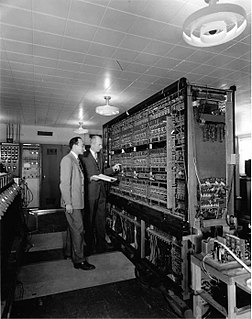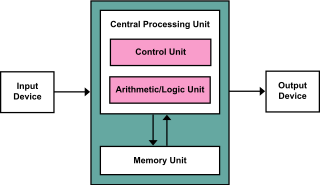
Argonne National Laboratory is a science and engineering research national laboratory operated by UChicago Argonne LLC for the United States Department of Energy. The facility is located in Lemont, Illinois, outside of Chicago, and is the largest national laboratory by size and scope in the Midwest.

The IAS machine was the first electronic computer to be built at the Institute for Advanced Study (IAS) in Princeton, New Jersey. It is sometimes called the von Neumann machine, since the paper describing its design was edited by John von Neumann, a mathematics professor at both Princeton University and IAS. The computer was built from late 1945 until 1951 under his direction. The general organization is called von Neumann architecture, even though it was both conceived and implemented by others. The computer is in the collection of the Smithsonian National Museum of American History but is not currently on display.

The AVIDAC or Argonne Version of the Institute's Digital Automatic Computer, an early computer built by Argonne National Laboratory, was partially based on the IAS architecture developed by John von Neumann. It was built by the Laboratory's Physics Division for $250,000 and began operations on January 28, 1953.
The Cyclone, was a vacuum tube computer, built by Iowa State College at Ames, Iowa. The computer was commissioned in July 1959. It was based on the IAS architecture developed by John von Neumann. The prototype was ILLIAC, the University of Illinois Automatic Computer. The Cyclone used 40-bit words, used two 20-bit instructions per word, and each instruction had an eight-bit op-code and a 12-bit operand or address field. In general IAS-based computers were not code compatible with each other, although originally math routines which ran on the ILLIAC would also run on the Cyclone.
The MANIAC I was an early computer built under the direction of Nicholas Metropolis at the Los Alamos Scientific Laboratory. It was based on the von Neumann architecture of the IAS, developed by John von Neumann. As with all computers of its era, it was a one-of-a-kind machine that could not exchange programs with other computers. Metropolis chose the name MANIAC in the hope of stopping the rash of silly acronyms for machine names, although von Neumann may have suggested the name to him.

WEIZAC was the first computer in Israel, and one of the first large-scale, stored-program, electronic computers in the world.

The von Neumann architecture — also known as the von Neumann model or Princeton architecture — is a computer architecture based on a 1945 description by John von Neumann, and by others, in the First Draft of a Report on the EDVAC. The document describes a design architecture for an electronic digital computer with these components:

Jack Joseph Dongarra is an American computer scientist. He is the American University Distinguished Professor of Computer Science in the Electrical Engineering and Computer Science Department at the University of Tennessee. He holds the position of a Distinguished Research Staff member in the Computer Science and Mathematics Division at Oak Ridge National Laboratory, Turing Fellowship in the School of Mathematics at the University of Manchester, and is an adjunct professor in the Computer Science Department at Rice University. He served as a faculty fellow at the Texas A&M University Institute for Advanced Study (2014–2018). Dongarra is the founding director of the Innovative Computing Laboratory at the University of Tennessee.
The ORACLE or Oak Ridge Automatic Computer and Logical Engine, an early computer built by Oak Ridge National Laboratory, was based on the IAS architecture developed by John von Neumann.

The United States Department of Energy National Laboratories and Technology Centers are a system of facilities and laboratories overseen by the United States Department of Energy (DOE) for scientific and technological research. Sixteen of the seventeen DOE national laboratories are federally funded research and development centers administered, managed, operated and staffed by private-sector organizations under management and operating (M&O) contract with DOE.
Ian Tremere Foster is a New Zealand-American computer scientist. He is a distinguished fellow, senior scientist, and director of the Data Science and Learning division at Argonne National Laboratory, and a professor in the department of computer science at the University of Chicago.
The Parallel Virtual File System (PVFS) is an open-source parallel file system. A parallel file system is a type of distributed file system that distributes file data across multiple servers and provides for concurrent access by multiple tasks of a parallel application. PVFS was designed for use in large scale cluster computing. PVFS focuses on high performance access to large data sets. It consists of a server process and a client library, both of which are written entirely of user-level code. A Linux kernel module and pvfs-client process allow the file system to be mounted and used with standard utilities. The client library provides for high performance access via the message passing interface (MPI). PVFS is being jointly developed between The Parallel Architecture Research Laboratory at Clemson University and the Mathematics and Computer Science Division at Argonne National Laboratory, and the Ohio Supercomputer Center. PVFS development has been funded by NASA Goddard Space Flight Center, The DOE Office of Science Advanced Scientific Computing Research program, NSF PACI and HECURA programs, and other government and private agencies. PVFS is now known as OrangeFS in its newest development branch.
The Office of Science is a component of the United States Department of Energy (DOE). The Office of Science is the lead federal agency supporting fundamental scientific research for energy and the Nation’s largest supporter of basic research in the physical sciences. The Office of Science portfolio has two principal thrusts: direct support of scientific research and direct support of the development, construction, and operation of unique, open-access scientific user facilities that are made available for use by external researchers.

Speakeasy was a numerical computing interactive environment also featuring an interpreted programming language. It was initially developed for internal use at the Physics Division of Argonne National Laboratory by the theoretical physicist Stanley Cohen. He eventually founded Speakeasy Computing Corporation to make the program available commercially.

The Government College of Engineering Karunagappally (CEK) is a public institute of engineering and technology in Karunagappally, in the north-west of Kollam district, Kerala, India. Established in 1999 by the Government of Kerala, it is the second engineering college in Kollam district the fourth engineering college under the aegis of the state government's Institute of Human Resources Development in Electronics. The institute is affiliated to the A P J Abdul Kalam Technological University, Recognized by AICTE and Accredited by National Board of Accreditation(NBA). It is the second engineering College in the Kerala Section to win the prestigious IEEE Region 10(Asia - Pacific) Exemplary Student Branch Award, Only student branch in Asia Pacific Region to win the IEEE MGA Regional Exemplary Student Branch Award twice in a row.
Margaret Kampschaefer Butler was a mathematician who participated in creating and updating computer software. During the early 1950s, Butler contributed to the development of early computers. Butler was the first female fellow at the American Nuclear Society and director of the National Energy Software Center at Argonne. Butler held leadership positions within multiple scientific organizations and women's groups. She was the creator and director of the National Energy Software Center. Here, Butler operated an exchange for the editing of computer programs in regards to nuclear power and developed early principles for computer technology.

Valerie Elaine Taylor is an American computer scientist who is the director of the Mathematics and Computer Science Division of Argonne National Laboratory in Illinois. Her research includes topics such as performance analysis, power analysis, and resiliency. She is known for her work on "Prophesy," described as "a database used to collect and analyze data to predict the performance on different applications on parallel systems."
Rick Stevens is a professor of computer science at the University of Chicago and associate laboratory director for Computing, Environment and Life Sciences (CELS) at Argonne National Laboratory.
Katarzyna Keahey is a Senior Computer Scientist at Argonne National Laboratory and the Consortium for Advanced Science and Engineering (CASE) of the University of Chicago. She is a Principal Investigator (PI) of the Chameleon project, which provides an innovative experimentation platform for computer science systems experiments. She created Nimbus, one of the first open source implementations of infrastructure-as-a-Service (IaaS), and co-founded the SoftwareX journal, publishing software as a scientific instrument.









